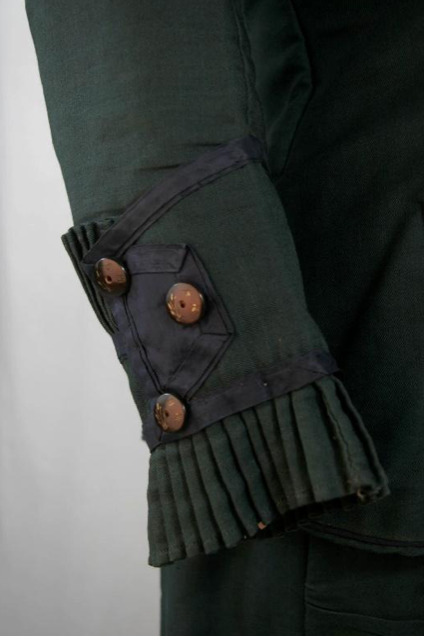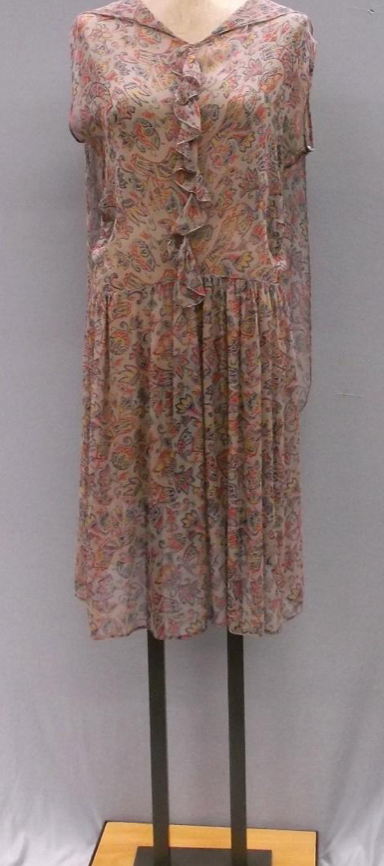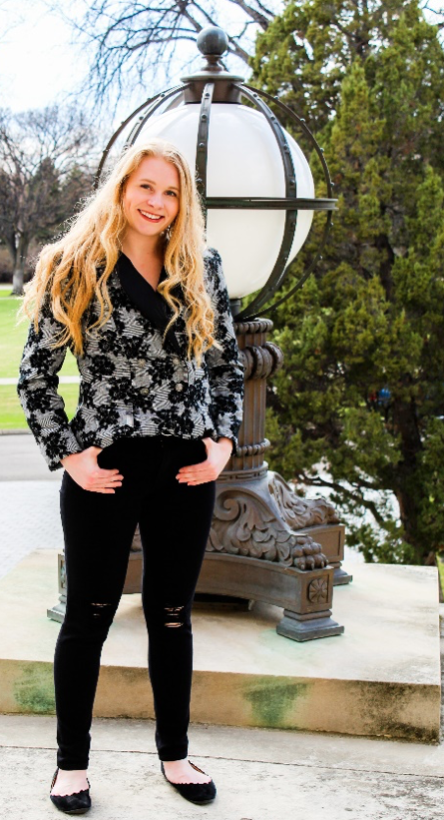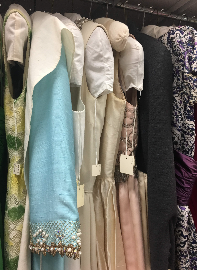

Written by Jacey Mayer- NDSU Senior and IFD Summer Intern 2020
Imagine walking into a room and instantly feeling like you’re traveling through various time periods represented by pieces of fashion. Moveable shelving with hundreds of garments, tagged by the decades they were made in, and who it was donated by. A closet, rich in history dating as far back as the late 1800s. The Emily Reynold’s Historical Costume Collection at North Dakota State University represents an endless time capsule in which these pieces have been preserved so they can be admired for years to come. The vision of Professor Emily Reynold’s was to allow students a hands-on experience of learning and recognizing different design techniques, history, and to potentially gain inspiration for their own designs.

The collection was started by Emily Reynold’s in the 1970s, and now contains over 5,000 unique pieces including accessories such as shoes, hats, and gloves. Some pieces in the collection have been donated by local political figures such as the past governor’s wives and former state representatives. The collection is a beautiful work of art as well as an informative study tool utilized by students to help gain a better understanding of historical fashion. Each piece has been carefully preserved with the assistance of a Smithsonian consultant, organized, and cataloged to make the pieces easily accessible.

Emily was initially a secondary school teacher in Tioga, ND. She then attended the University of Tennessee to receive her Masters of Science. She later returned to NDSU and became a professor. As the Department Chair from 1948 to 1981, she expanded the faculty and curriculum for the Textiles and Clothing department. She was very involved on campus and resonated with the students.
While working on an assignment for my apparel construction course, I came across a double-breasted dress from the early 1900 in the collection and thought the top details of the dress would be a beautiful concept as a jacket, with its v-neckline and double-breasted closure. Although I wasn’t able to find a pattern that specifically had the same design concept, I was able to find a 1940s pattern that loosely resembled the 1910s dress and made modifications to the pattern such as extending the sleeve length and implementing a collar to create the same v-shaped neckline. I also adjusted the button placement and eliminated 2 sets of the buttons, creating the jacket I had originally envisioned.
Countless students just like me have been inspired by the The Emily Reynold’s Historical Costume Collection at North Dakota State University. Here are some highlights from this gem of a collection:

Emerald Green Silk Taffeta Evening Gown
One of the most iconic pieces in the Historical Costume Collection is this Emerald Green evening gown. On January 20th, 1961, Jocelyn Burdick wore this beautiful evening gown to John F. Kennedy’s Inaugural Ball. She was appointed to fill her husband, Quentin Burdick’s position on the US Senate after his death in 1992. Jocelyn was the first woman to represent North Dakota in the US senate until a special election was held to properly elect his replacement. During her time in the US Senate, she became a strong supporter of women’s rights and was able to add her name to legislation in support of pay equity and women’s health.
Design details: The simple, yet elegant emerald green gown, was made from a Silk Taffeta material fully lined in green satin. The top of consists of a drape bodice with square neckline, shoulder straps, and a zipper closure. The skirt is draped as well, with a boned waist. It is part of the ERHCC’s Women in Politics Collection.
Sleeveless evening “Flapper Girl” dress
This dress is what one would envision as the stereotypical flapper girl dress. In fact, it was worn by Esther Nesmith Breed during her younger years in the 1920s. During this era, she attended college for one year and then spent the rest of her time traveling around Europe. She was often described as the “flapper girl” by her friends and family.
Design details: This “flapper girl” dress consists of many fine details such as champagne-colored crushed velvet, as well as lined with champagne- colored Chiffon lining, and has a scoop neckline. The bodice is shirred into the shoulders with two stripes of beading. The dress also contains intricate beadwork of pearls, silver bugle beads, and clear rhinestones down the sides of bodice front, which then merges into a wide band. The scalloped hem is also heavily beaded with teardrop-shaped cutouts at the waist and hem. The back has a beautiful T-shaped opening and is also outlined in beading.
Fuschia/ Black Floral Silk Tapestry Three Piece Ensemble
This three-piece ensemble was purchased by Fargo woman, Anne Libby Goldberg during the 1960s. She saw a photograph of First Lady Mamie Eisenhower wearing the coat and dress ensemble and instantly fell in love with the look. She then purchased the Nat Kaplan pieces. After receiving the pieces, she commissioned local milliner, Margaret Steiner to make a hat to match the dress and coat.
Design details: Not only are all three pieces made from the same beautiful floral silk material, the dress and coat both have princess seams and bust darts. The dress consists of a rounded neck and short sleeves. The back closure is a zipper with a hook and eye at the neck. The coat has a mandarin collar and three-quarter length sleeves. The coat’s closure has five black rhinestone studded buttons on the front. Both the hat and the coat are lined with black satin. The hat itself, has a turned-up brim, a round crown, and is gathered to back with two self-fabric hat pins.
Sleeveless orange/blue/black floral print brocade dress.
This brocade party dress dates back to 1924 and was worn by Newlywed Beatrice Burns Zimmerman. In her younger years, she wore it to parties in Casselton, ND especially during the winter of 1924-1925. She graduated from the University of North Dakota in 1922 with a major in Home Economics with a minor in both Chemistry and Physical Education. Shortly after she married Edwin C. Zimmerman. They had three children and moved to Fargo in 1948. Beatrice taught Red Cross Home Nursing at what is now considered North Dakota State University but at the time it was known as NDAC. In 1956, Beatrice became the first person to earn a masters degree in Home Economics at North Dakota State University.
Design details: Shots of gold metallic thread run throughout the floral brocade fabric. The neckline is a scoop neck with an attached black velvet capelet which has long points at the front. The dress comes completed with a drop waist with a scalloped edge attached to a short, pleated skirt made from the same black velvet material as the capelet.
Blue Rayon Chiffon with White Flower and Butterfly Print Dress and Underdress
In the 1940s, military goods made from natural fibers, leather, and rubber were prioritized during production over civilian clothing and shoes. The Regulation L-85 issued in 1942 by the government’s War Production Board, prioritized the conservation of fabric and trims by 15 percent on women’s clothing which created regulations for manufacturers only allowing them to use a yard and three quarters of fabric for the garment. They also prohibited design details such as the use of ruffles, patch pockets, and attached hoods. Although these strict regulations were implemented for manufacturers, home sewing was not affected by the regulations. Most women opted to follow guidelines anyways because fabric was hard to obtain. This dress was made by Helga Olson to be worn by her daughter and followed the regulations placed during the war era.
Design details: To accommodate the regulations three snaps were utilized to close the left side of the under dress. To save fabric, the A-line dress also only has pleats on the front of the skirt, short sleeves, a small integral band collar, and uses narrow tucks on the bodice. It also has white plastic buttons for the closure down the front of the dress. The self-fabric belt carriers at the waist so the skirt of the underdress is exposed.
Men’s Dusty Rose Polyester suit
Professor Peter Munton, former chair of the Design department at NDSU. This suit was purchased at Young America, Minnesota, in 1972. Although this suit was trendy for the time it did not remain in style as time went on. It is also a good representation of the Peacock Revolution in men’s fashion, which took place during the 1960s.
Design details: The double-breasted jacket is made from a dusty rose polyester material and includes a 12 dark gray button closure down the front. The wide notched collar comes to a point at the center back. The front of the jacket has two slightly curved seams for shaping and two v tab inset pockets also lie along the seams. On the back of the jacket there is a faux topstitched belt that comes to a point similar to the collar. The jacket comes complete with long sleeves with three decorative buttons at the cuff. The inside of the coat is lined with blue, red, and light gray colored taffeta material. The inside of the coat also has a chest pocket at the left with a button closure. The pants are also made from a dusty rose polyester material with brown and ecru vertical stripes. The pants have a slight bell bottom flare with a front fly closure. They also include 2 front pockets, 2 back pockets, and 5 belt loops with a metal hook on the waistband.
Two-Piece Green Wool Dress
Being one of the oldest pieces in the collection, the two-piece green wool dress worn by Inga Hovland in 1885, was what she wore on board the ship that brought her to America from Norway. Hovland was 33 years old when she immigrated to the US. 5 years later, she married Sam Hovland in Minnesota, but they settled in Trail County, ND where they farmed and raised a family.
Design details: The top bodice includes a fitted waist and has a 12-button center closure and includes a blue mandarin collar edged with lace. The long sleeves consist of cartridge pleats at the cuffs accented with three buttons, blue ribbon, and lace. The back of the top has a slight flare in the back and the inside is fully lined. The matching skirt is floor length with 4 rows of cartridge pleats at the hemline and blue-ribbon trim. The back of the skirt is slightly gathered in back to create a bustle. The skirt is also fully lined.

Navy Blue Wool Twill A-line Coat
Although upcycling has become more of a trend in recent years, this coat from the late 60’s was made by Dorothy Novak for her daughter from a recycled adult’s coat. Dorothy was known for being resourceful and taking old articles of clothing and fashioning them into clothes for her children.
Design details: The A-line coat was made from a navy-blue wool twill material with black sharkskin facings, and a blue cotton lining. The coat features a rolled collar and 4 white pearl buttons as the front closure.

Blue and White striped Chambray two-piece dress
This two-piece dress dates back to the 1940s and was made by North Dakota farm wife, Gladys Olson Pruess. She would wear this dress to run errands in town, club meetings, or to pickup/deliver grain at the elevator.
Design details: Fun fact, the top had originally had blue glass buttons Glady’s had recycled from her wedding dress. However, she removed them and put them on a different dress. The buttons were replaced with white plastic buttons. The blouse has a flat, wide collar with rounded ends, and short sleeves with turned-back cuffs. The bodice has pleats at the lower half on both the front and back. A patch pocket can be found on the left chest. The skirt is a simple A-line cut and has a side button closure at the waistband due to the shortage of material because of the war.
Sleeveless floral print Silk Georgette Summer Dress
In the late 1920s, this dress was made for Alma Stockstad Gilbertson by her mother. Her mother, Aletthe Stockstad, was a skilled dressmaker and made this dress using a commercial pattern. Because her mother often made her dresses, Alma did not own a ready-to-wear dress until after she graduated high school.
Design details: This multicolored floral print dress is made from a silk Georgette material and has a V-neckline with a self-fabric ruffle down the center front. The unique collar is designed to have a waist-length capelet that attaches to the back shoulders. The bodice side seams are ruched with dropped waist and a gathered skirt.
Rosemari Myrdal purchased the dark gray woven wool coat in 1995 to wear during her daily walk to work at the state capitol in Bismarck, ND, where she served as Lieutenant Governor from 1993-2001. She religiously walked four blocks to work multiple times a day regardless of the temperatures, even when the wind chill was below zero. She also served in the North Dakota House of Representatives from 1985-1992.
Mid-Calf length dark gray woven wool coat with off-white polar bears
The coat was purchased in a shop in Minneapolis airport on her way home from a conference. Since she has a Nordic and Northeastern North Dakota Heritage, the coat quickly caught her eye and she knew she needed to purchase it. The Lillunn company that produced the jacket was founded in Norway in 1953 by Unn Søiland Dale. Dale was inspired by deck blankets on a cruise ship and began designing coats made from Norwegian wool blankets.
Design details: The wool coat falls to a mid-calf-length and has a tall stand-up collar that closes with two plastic buttons. The wrap front closes with plastic buttons at the shoulder and the waist. It has long sleeves with turn-back cuffs, inseam pockets, and the edges are finished with gray machine serging.
Emily Reynolds started with a vision and was able to turn a simple concept into a historical masterpiece for people to admire for years to come. After Emily’s retirement in 1995, Professor Anne Braaten from the Apparel Department stepped up to be the Curator for the collection which is also managed by Susan Curtis. The collection is available for tours on a limited basis. If you are interested in visiting the Collection, please contact Susan Curtis at ndsu.erhcc@ndsu.edu.
Photo credit: North Dakota State University, Emily Reynold’s Historical Costume Collection. ndsu.edu.

My Personal Inspiration Experience
I, Jacey Mayer, from personally being a student at North Dakota State University, and being in the Apparel program have my own special story of how the collection has positively impacted my education. I have spent hours in the costume collection searching for inspiration. I love admiring the craftsmanship and hearing the interesting stories behind the garments. In classes such as history of fashion I have had many lectures where my professor has brought in pieces from the collection to properly show us specific design details.
Once while working on an assignment for my apparel construction course, I came across a double-breasted dress from the early 1900 in the collection and thought the top details of the dress would be a beautiful concept as a jacket. I took a picture to capture the specific elements (as seen on the top right) I was looking for such as the v-neckline and double-breasted closure. I then searched for a pattern that had those design elements within it. I didn’t find exactly what I was looking for. Although I wasn’t able to find a pattern that specifically had the same design concept, I was able to find a 1940s pattern that loosely resembled the 1910s dress and made modifications to the pattern such as extending the sleeve length, implementing a collar to create the same v-shaped neckline. I also adjusted the button placement and eliminated 2 sets of the buttons. Therefore creating the jacket, I had originally envisioned.
Wrap up!
The collection is a beautiful work of art as well as an informative study tool utilized by students to help gain a better understand of historical fashion. Each piece has been carefully preserved with the assistance of a Smithsonian consultant, organized, and cataloged to make the pieces easily accessible. Emily Reynolds started with her vision and was able to turn a simple concept into a historical masterpiece for people to admire for years to come. After Emily’s retirement in 1995, Professor Anne Braaten from the Apparel Department stepped up to be the Curator for the collection and the collection is also managed by Susan Curtis today.
North Dakota State University. (n.d.). Emily Reynold’s Historical Costume Collection. ndsu.edu. https://www.ndsu.edu/erhcc/

Thank you to Jacey for contributing such great content. For more information about NDSU’s Apparel program, visit: https://www.ndsu.edu
Interested in learning more about IFD internships? Send a note to: design@insidefashiondesign.net















































































Comentarios